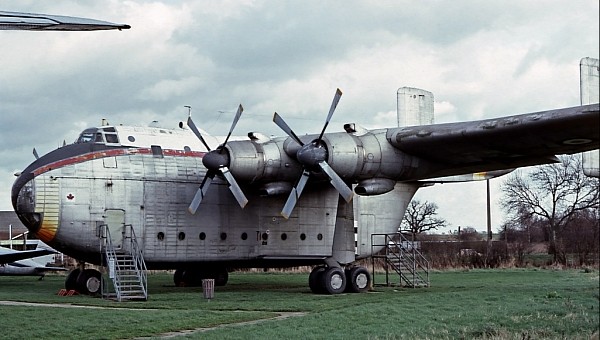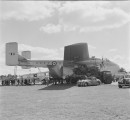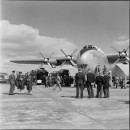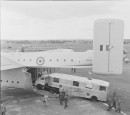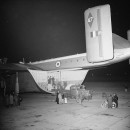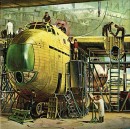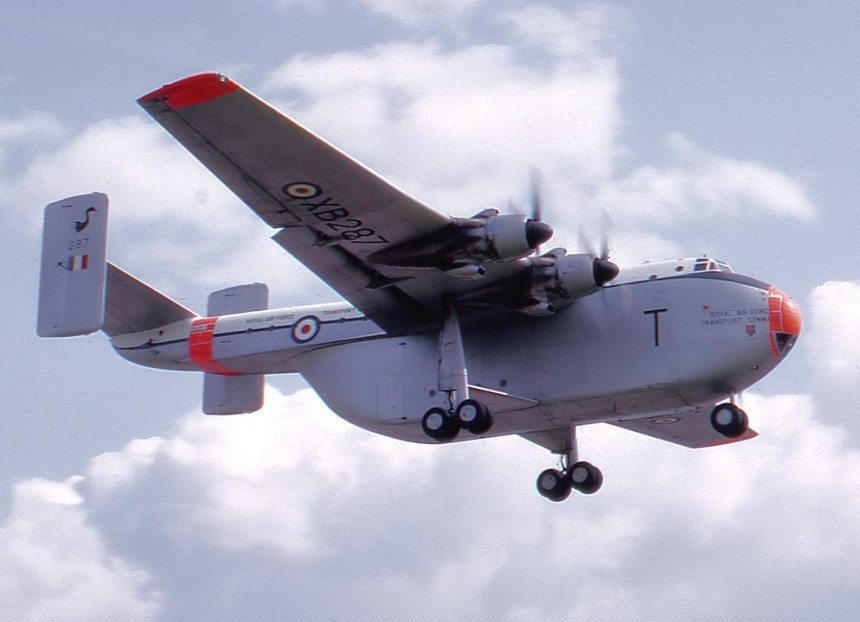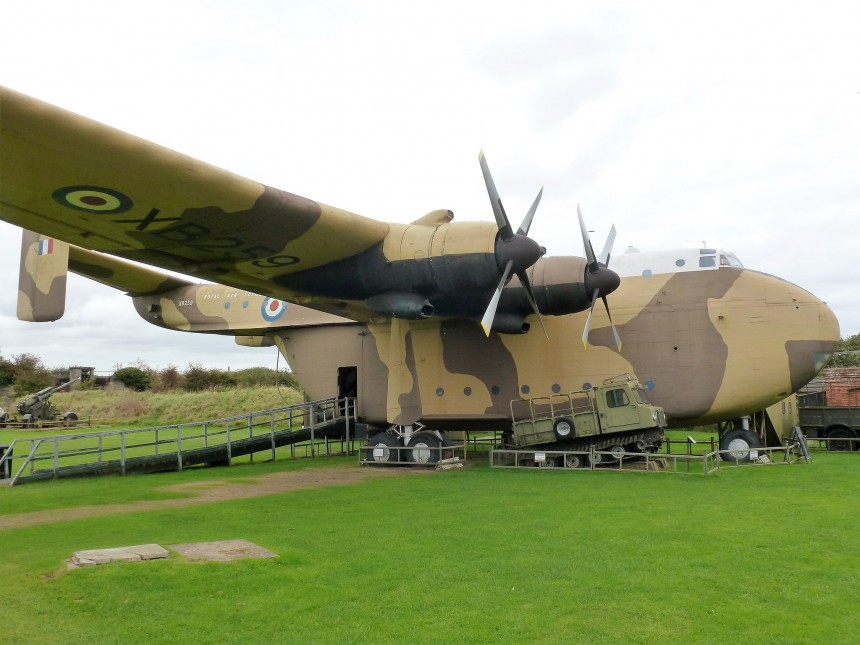Back in 2018, the YouTube page for the niche aviation forum hushkit.net posted a video in which they labeled one particular post-WWII cargo plane as number ten on their list of the ten worst British military aircraft ever made. Surprisingly for such a forgotten airplane, this elicited a rather unusual negative reaction from some people.
One YouTuber responded with a clap-back video of sorts, asking what it was Hush Kit was smoking when they came up with this list. As a result, we've come upon a story we're sure even most military aviation geeks might not have heard about yet. This is the tale of the Blackburn Beverly, the most misunderstood cargo plane that ever flew.
Aviation junkies who knew the story of what might look like a C-130 with a messed up aspect ratio decried comparing it to the Hercules as a little unfair. The reason why is that even though the Beverly deployed in 1955, just a year before the Lockheed C-130A, the impetus for its production dates back to just after the end of World War II.
By the end of the war, the bulk of Royal Air Force cargo duty had long been designated to American Lend-Lease airplanes like the Douglas C-47 Dakota/Skytrain and the Curtiss C-46 Commando. Alongside a handful of domestic designs like the Armstrong Whitworth Albemarle, the Vickers Warwick, and the De Haviland Albatross. Once the dust over Europe and the Pacific settled, it was clear a home-grown replacement for all of these crusty cargo planes was an utmost priority.
General Aircraft, makers of the Hamilcar cargo transport glider, had been working on a design for a domestic quad-engine military cargo plane for some time by 1945. The company's chief designer, a man called F. F. Crocombe, first devised the concept way back in 1939. In its early stages, the plane was dubbed the GAL.60 and slated to be powered by four Rolls-Royce Merlin engines famous in the Spitfire and the American P-51D Mustang.
In 1946, the RAF Air Ministry issued Specification C.3/46. An invitation for design proposals calling for a medium-range tactical cargo aircraft with an 18,000-foot (5,486-meter) service ceiling and a maximum cargo load of 25,000 lbs (11,339.8 kg), or 5,000 lbs more than the original design with Merlin engines.
The 14-cylinder Bristol Hercules was also considered for a time, being famous for its use in the Bristol Beaufighter and also the cuddly-looking but equally awful Saro Lerwick flying boat.
But the 135,000 lb (61,235 kg) fully-loaded design the Beverly became would have been too much even for a very sizeable radial engine. What was needed was nothing short of one of the largest piston engines ever built in large numbers, the Bristol Centaurus. Most famous for its use in the colossal Bristol Brabazon airliner and the Hawker Sea Fury carrier fighter, this 18-cylinder behemoth was only matched in large numbers by a handful of American engines like the Wright R-3350.
A special variant of the Centaurus dubbed the 373 was created specifically for the Beverly and produced an eye-watering 3,220 horsepower. For unknown reasons, this variant was never fitted to a production Blackburn Beverly. Instead, a more modest variant, 173 variants with 2,850 horsepower each. Though undoubtedly a lot of power, this grunt was meant to haul massive loads of cargo and people, not for speed.
A leisurely cruising speed of 238 mph (383 kph) may have been just fine in the early days of World War II. But in the skies above a global superpower armed with jet aircraft, the Beverly would have no hopes of maneuvering its way out of danger if fighter escorts failed to stop a threat. That said, a ferry range of 3,960 miles (6,370 km, 3,440 mi) was admirable for the time. With room for 100 or more troops in the cargo hold and the tail boom, this load could easily be swapped for nine jeeps or a single bulldozer-sized armored vehicle.
Interestingly, the doors for the in-flight lavatory were located painstakingly close to the opening of the Beverly's paratrooper doors at first. A modification was made to fix this when an RAF crew member fell 20 feet to the ground after falling out the paratrooper door after exiting the bathroom. To say it took a geological time scale in aeronautical terms to work out all the faults would be an understatement.
Making its maiden flight in 1950, the Beverly wouldn't enter RAF service until 1955. Resources in a still-rebuilding Great Britain after World War II were a fraction of what the mostly undamaged American war infrastructure had at its disposal. The YouTube channel Gyrocopter flying club pointed this out in their response to the Beverly's place on the worst aircraft ever list by displaying two photos back to back. One photo is of Lockheed's main factory in Burbank, California, and another of Blackburn's main facility in Brough, Yorkshire, in the North of England.
Comparing Blackburn's facility to that of Lockheeds is like comparing the U.S. Air Force to that of a "third-world" nation, whatever that means this month. The point is, even as Blackburn Aircraft merged with General Aircraft, the resources available to the new single company were a fraction of even America's least busy military aerospace contractor. A subsequent change in the Air Ministry's requirements soon after the airframe's first flight didn't help matters even slightly.
This fact goes to great lengths to explain why Beverly took a full half-decade to enter military service after its first flight. When the first 20 Beverlies did eventually enter service, they were placed with the Royal Air Force's No.47 Squadron based at RAF Abingdon Air Base in Oxfordshire. The aircraft delivered made regular cargo runs to RAF bases in Germany, a country yet to be fully rehabilitated by the victorious Allies after the end of the Second World War. Though no doubt ungainly, the Beverly was surprisingly solid at its primary role of a cargo plane.
That's in spite of engines that burned almost as much oil as they did gasoline and fuel pumps that were very easy to accidentally install backward. If this were to happen in one or more engines and the airplane still managed to make it into the skies, the results should be as self-explanatory as they are catastrophic. Such an incident happened at least once, in March 1958, over Sutton Wick in Berkshire, England, with 18 fatalities in total. Nine of the 49 Beverly airframes Blackburn manufactured were lost in accidents or landmine/bomb attacks.
Meanwhile, as Hush Kit pointed out, to some people's dismay, the Lockheed C-130A Hercules was leaving factories in their hundreds beginning only a year after the Beverly entered RAF service. Sporting quad Allison T-56-A-A-15 turboprop engines with 3,750 shaft horsepower each, the C-130A's cruising speed of 336 mph (540 kph) would have ripped the wings off a Blackburn Beverly.
Though the Beverly's range out-classed early C-130s a bit, the more powerful and more capable Hercules was the clear way forward for dozens of Air Forces across the globe. Meanwhile, the Blackburn Beverly continued to serve with the RAF until 1967. The year prior, the RAF received their first orders of American C-130H variants. From that point on, the Beverly was truly toast.
Today, only a single Beverly exists in its entirety. It was on display, for some time, at the Fort Paull gun battery outside of Hull, England. As of 2021, the airframe was being disassembled and transported to an airfield in Selby, England. Somewhere along the way in 2022, roadblocks appeared in this process. This left the future of the sole surviving Blackburn Beverly in grave peril. Meanwhile, over 2,500 C-130s have been built since the 1950s, beating out the Beverly's entire production run approximately 50 times over.
Does this make the Beverly a signifier that America truly did build better airplanes than Great Britain? Well, on the one hand, the math doesn't lie. But on the other, it must be said a fair few British aviation geeks really do love the old warbird. Some folks love it enough, in fact, to genuinely feel despair when the last example finally bites the dust. For that reason alone, the Blackburn Beverly deserves a little bit of the spotlight.
Aviation junkies who knew the story of what might look like a C-130 with a messed up aspect ratio decried comparing it to the Hercules as a little unfair. The reason why is that even though the Beverly deployed in 1955, just a year before the Lockheed C-130A, the impetus for its production dates back to just after the end of World War II.
By the end of the war, the bulk of Royal Air Force cargo duty had long been designated to American Lend-Lease airplanes like the Douglas C-47 Dakota/Skytrain and the Curtiss C-46 Commando. Alongside a handful of domestic designs like the Armstrong Whitworth Albemarle, the Vickers Warwick, and the De Haviland Albatross. Once the dust over Europe and the Pacific settled, it was clear a home-grown replacement for all of these crusty cargo planes was an utmost priority.
General Aircraft, makers of the Hamilcar cargo transport glider, had been working on a design for a domestic quad-engine military cargo plane for some time by 1945. The company's chief designer, a man called F. F. Crocombe, first devised the concept way back in 1939. In its early stages, the plane was dubbed the GAL.60 and slated to be powered by four Rolls-Royce Merlin engines famous in the Spitfire and the American P-51D Mustang.
The 14-cylinder Bristol Hercules was also considered for a time, being famous for its use in the Bristol Beaufighter and also the cuddly-looking but equally awful Saro Lerwick flying boat.
But the 135,000 lb (61,235 kg) fully-loaded design the Beverly became would have been too much even for a very sizeable radial engine. What was needed was nothing short of one of the largest piston engines ever built in large numbers, the Bristol Centaurus. Most famous for its use in the colossal Bristol Brabazon airliner and the Hawker Sea Fury carrier fighter, this 18-cylinder behemoth was only matched in large numbers by a handful of American engines like the Wright R-3350.
A special variant of the Centaurus dubbed the 373 was created specifically for the Beverly and produced an eye-watering 3,220 horsepower. For unknown reasons, this variant was never fitted to a production Blackburn Beverly. Instead, a more modest variant, 173 variants with 2,850 horsepower each. Though undoubtedly a lot of power, this grunt was meant to haul massive loads of cargo and people, not for speed.
A leisurely cruising speed of 238 mph (383 kph) may have been just fine in the early days of World War II. But in the skies above a global superpower armed with jet aircraft, the Beverly would have no hopes of maneuvering its way out of danger if fighter escorts failed to stop a threat. That said, a ferry range of 3,960 miles (6,370 km, 3,440 mi) was admirable for the time. With room for 100 or more troops in the cargo hold and the tail boom, this load could easily be swapped for nine jeeps or a single bulldozer-sized armored vehicle.
Making its maiden flight in 1950, the Beverly wouldn't enter RAF service until 1955. Resources in a still-rebuilding Great Britain after World War II were a fraction of what the mostly undamaged American war infrastructure had at its disposal. The YouTube channel Gyrocopter flying club pointed this out in their response to the Beverly's place on the worst aircraft ever list by displaying two photos back to back. One photo is of Lockheed's main factory in Burbank, California, and another of Blackburn's main facility in Brough, Yorkshire, in the North of England.
Comparing Blackburn's facility to that of Lockheeds is like comparing the U.S. Air Force to that of a "third-world" nation, whatever that means this month. The point is, even as Blackburn Aircraft merged with General Aircraft, the resources available to the new single company were a fraction of even America's least busy military aerospace contractor. A subsequent change in the Air Ministry's requirements soon after the airframe's first flight didn't help matters even slightly.
This fact goes to great lengths to explain why Beverly took a full half-decade to enter military service after its first flight. When the first 20 Beverlies did eventually enter service, they were placed with the Royal Air Force's No.47 Squadron based at RAF Abingdon Air Base in Oxfordshire. The aircraft delivered made regular cargo runs to RAF bases in Germany, a country yet to be fully rehabilitated by the victorious Allies after the end of the Second World War. Though no doubt ungainly, the Beverly was surprisingly solid at its primary role of a cargo plane.
Meanwhile, as Hush Kit pointed out, to some people's dismay, the Lockheed C-130A Hercules was leaving factories in their hundreds beginning only a year after the Beverly entered RAF service. Sporting quad Allison T-56-A-A-15 turboprop engines with 3,750 shaft horsepower each, the C-130A's cruising speed of 336 mph (540 kph) would have ripped the wings off a Blackburn Beverly.
Though the Beverly's range out-classed early C-130s a bit, the more powerful and more capable Hercules was the clear way forward for dozens of Air Forces across the globe. Meanwhile, the Blackburn Beverly continued to serve with the RAF until 1967. The year prior, the RAF received their first orders of American C-130H variants. From that point on, the Beverly was truly toast.
Today, only a single Beverly exists in its entirety. It was on display, for some time, at the Fort Paull gun battery outside of Hull, England. As of 2021, the airframe was being disassembled and transported to an airfield in Selby, England. Somewhere along the way in 2022, roadblocks appeared in this process. This left the future of the sole surviving Blackburn Beverly in grave peril. Meanwhile, over 2,500 C-130s have been built since the 1950s, beating out the Beverly's entire production run approximately 50 times over.
